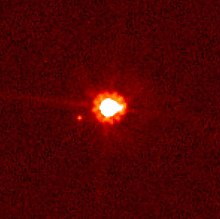Eris (dwarf planet)
Eris (symbol ![]() )[1] is a dwarf planet and a trans-Neptunian object (TNO).[2] It is the second-largest known dwarf planet in the Solar System. Eris is slightly smaller than Pluto, but it has more mass than Pluto.
)[1] is a dwarf planet and a trans-Neptunian object (TNO).[2] It is the second-largest known dwarf planet in the Solar System. Eris is slightly smaller than Pluto, but it has more mass than Pluto.


It is a "scattered disc object" in the Kuiper belt, further out than Pluto. It is also called a plutoid because the IAU decided to rename all trans-Neptunian dwarf planets as plutoids.[3] Eris orbits the sun once every 557 Earth years.[4] It has an elliptical orbit, inclined at an angle of 44° between the plane of the orbit of the planet and the ecliptic, the plane containing Earth's orbital path.[5]
Discovery
change136199 Eris was discovered by Michael E. Brown, Chad Trujillo and David Rabinowitz[6] on January 5, 2005, when they were having a close look at some images of the outer Solar System taken in 2003.
Naming
change136199 Eris was originally called Xena, after the main character of the television series Xena: Warrior Princess.[4] Due to complications, it was officially named 136199 Eris on September 13, 2006.[7] Eris is named after the goddess of strife, discord, [8][4] contention and rivalry in Greek mythology.[9]
Moon of 136199 Eris
change136199 Eris has one moon called Dysnomia.[10] It was discovered on September 10, 2005.[8] Dysnomia was originally nicknamed Gabrielle, after a character from the television series Xena: Warrior Princess, like 136199 Eris. However, like 136199 Eris, it was renamed to Dysnomia due to complications. Dysnomia was named after the daughter of 136199 Eris, in Greek mythology. Dysnomia is the goddess (or spirit) of lawlessness[8][4] and poor civil constitution.[11]
Classification
changeMedia reports have argued that 136199 Eris is the tenth planet, along with astronomers and NASA scientists.[12][13] However, the definition of a planet was changed in August 2006.[14] Under the new specifications, 136199 Eris, along with 134340 Pluto, was lowered in status to a dwarf planet.
Future
changeScientists continue to find out more about Eris and its moon, and look for more moons and possible rings. Because Eris is so far away, it would take 24.5 years to visit Eris with a space probe.[15]
References and notes
change- ↑ JPL/NASA (2015-04-22). "What is a Dwarf Planet?". Jet Propulsion Laboratory. Retrieved 2022-01-19.
- ↑ Formal designation: 136199 Eris; Provisional designation: 2003 UB313.
- ↑ Lang, Kenneth R. (2011). The Cambridge Guide to the Solar System (Second ed.). Cambridge University Press. p. 442. ISBN 978-0-521-19857-8.
- ↑ 4.0 4.1 4.2 4.3 Harvey, Samantha (2011-03-24). "NASA: Solar System Exploration: Planets: Dwarf Planets: Eris". NASA. Archived from the original on 2013-02-02. Retrieved 2011-03-31.
- ↑ Sicardy, B.; Ortiz, J. L.; Assafin, M.; Jehin, E.; Maury, A.; Lellouch, E.; Gil-Hutton, R.; Braga-Ribas, F.; Colas, F.; Widemann (2011). "Size, density, albedo and atmosphere limit of dwarf planet Eris from a stellar occultation" (PDF). European Planetary Science Congress Abstracts. 6: 137–138. Bibcode:2011epsc.conf..137S. Retrieved 2016-02-19.
- ↑ Harvey, Samantha (2011-03-24). "NASA: Solar System Exploration: Planets: Dwarf Planets: Eris: Facts & Figures". NASA. Archived from the original on 2013-10-07. Retrieved 2011-04-04.
- ↑ Brown, Mike. "The discovery of
2003 UB313Eris, the10th planetlargest known dwarf planet". Caltech. Retrieved 2011-04-04. - ↑ 8.0 8.1 8.2 Brown, Mike. "Dysnomia, the moon of Eris". Caltech. Retrieved 2011-04-02.
- ↑ Atsma, Aaron J. "ERIS". Theoi Project: Greek Mythology. Retrieved 2011-04-03.
- ↑ Also with the provisional designation: 2003 UB313.
- ↑ Atsma, Aaron J. "DYSNOMIA". Theoi Project: Greek Mythology. Retrieved 2011-04-02.
- ↑ Whitehouse, David (2005-07-30). "Astronomers detect '10th planet'". BBC. Retrieved 2011-04-03.
- ↑ "10th Planet Discovered". NASA. 2005-07-29. Retrieved 2011-04-03.
- ↑ Hamilton, Calvin J. "Dwarf Planets". Views of the Solar System. Retrieved 2011-04-03.
- ↑ McGranaghan, R.; Sagan, B.; Dove, G.; Tullos, A.; Lyne, J. E.; Emery, J. P. (2011). "A Survey of Mission Opportunities to Trans-Neptunian Objects". Journal of the British Interplanetary Society. 64: 296–303. Bibcode:2011JBIS...64..296M
Related pages
changeOther websites
change- Harvey, Samantha. "Eris Profile". NASA. Archived from the original on 2013-02-02. Retrieved 2011-04-03.
- Harvey, Samantha. "Eris: Facts & Figures". NASA. Archived from the original on 2013-10-07. Retrieved 2011-04-04.
- Brown, Mike. "The discovery of
2003 UB313Eris, the10th planetlargest known dwarf planet". Caltech. Retrieved 2011-04-04.